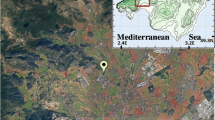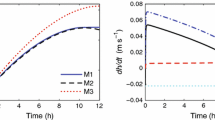Abstract
The heat input into the planetary boundary layer (PBL) resulting from surface-atmosphere interactions under extremely arid conditions is formulated as a linear differential equation. The forcing for this heat input is the product of the shortwave (solar) absorption at the surface and the surface-to-PBL heat transfer efficiency, η. This efficiency is determined by five variables: the turbulent heat transfer coefficient, the soil heat conductance, the surface longwave emissivity, the surface temperature, and the fraction of the longwave flux from the surface absorbed within the PBL. The first two variables may vary by orders of magnitude, while the others vary much less.
If a simplifying assumption is made that these variables and the thickness of the PBL do not vary with time, and that the shortwave absorption by the surface is given by a half-sine wave, then the PBL temperature cycle can be explicitly expressed (by exponential and trigonometric functions) as dependent on only two system parameters: (i) the system time constant and (ii) the transfer efficiency η divided by the thermal capacity of the PBL. The shape of this diurnal cycle depends solely on the system time constant, which is a simple function of the thermal capacity of the PBL, the PBL temperature, and the same variables that define η. For a small time constant, the peak PBL temperature will occur near noon, while for large values it will occur close to sunset. The amplitude of this diurnal cycle is proportional to the product of η and the peak (noon) shortwave absorption at the surface, and also depends very strongly on the system time constant.
A concept of trans-absorptivity, that specifies the heat input into the PBL resulting from the shortwave absorption by the surface, is introduced and discussed in terms of the governing equations. The trans-absorptivity is given as the product of the surface absorptivity (the co-albedo) and the efficiency η. It is suggested that climatic effects of surface changes, such as removal of vegetation, should be formulated in terms of changes in the trans-absorptivity.
Similar content being viewed by others

References
Chagnon, S. A. Jr.: 1970, ‘Recent Studies of Urban Effects on Precipitation in the United States, Urban Climatology’, W.M.O.Tech. Note 108, 325–341.
Ching, J. K. S.: 1985, ‘Urban Scale Variations of Turbulence Parameters and Fluxes’, Boundary-Layer Meteorol. 33, 335–362.
Fuchs, M. and Tanner, C. B.: 1967, ‘Evaporation from a Drying Soil’, J.Appl. Meteorol. 6, 852–857.
Geiger, R.: 1975, The Climate Near the Ground, Harvard University Press, Cambridge, Mass., 611 pp.
Kornfield, J. and Susskind, J.: 1977, ‘On the Effects of Surface Emissivity on Temperature Retrievals’, Monthly Weather Review 105, 1605–1608.
Landsberg, H. E.: 1981, The Urban Climate, Academic Press, New York, NY, 275 pp.
Lettau, H.: 1951, ‘Theory of Surface-Temperature and Heat-Transfer Oscillations Near a Level Ground Surface’, Trans. Amer. Geophys. Union 32, 189–200.
Lettau, H.: 1977, ‘Climatonomical Modeling of Temperature Response to Dust Contamination of Antarctic Snow Surfaces’, Boundary-Layer Meteorol. 12, 213–229.
Monteith, J.: 1963, ‘Gas Exchange in Plant Communities’, in L. T. Evans (ed.), Environmental Control of Plant Growth, Academic Press, New York, pp. 95–112.
Novak, M. D. and Black, T. A.: 1985, ‘Theoretical Determination of the Surface Energy Balance and Thermal Regimes of Bare Soils’, Boundary-Layer Meteorol. 33, 313–333.
Otterman, J.: 1974, ‘Baring High-Albedo Soils by Overgrazing: A Hypothesized Desertification Mechanism’, Science 186, 3431–3438.
Otterman, J.: 1981a, ‘Satellite and Field Studies of Man's Impact on the Surface of Arid Regions’, Tellus 33, 68–77.
Otterman, J.: 1981b, ‘Plane with Protrusions as an Atmospheric Boundary’, J. Geophys. Res. 86, 6627–6630.
Otterman, J.: 1983, ‘Absorption of Insolation by Land Surfaces with Sparse Vertical Protrusions’, Tellus 35b, 309–318.
Otterman, J.: 1989, ‘Enhancement of Surface-Atmosphere Fluxes by Desert-Fringe Vegetation through Reduction of Surface Albedo and of Soil Heat Flux’, Theoretical and Appl. Climatol. 40, 67–79.
Otterman, J., Chou, M.-D., and Arking, A.: 1984, ‘Effects of Nontropical Forest Cover on Climate’, J. Climate Appl. Meteorol. 23, 762–767.
Rosenberg, N. J.: 1974, Microclimate: The Biological Environment, John Wiley and Sons, 315 pp.
Schmetz, J. and Beniston, M.: 1986, ‘Relative Effects of Solar and Infrared Radiative Forcing in a Mesoscale Model’, Boundary-Layer Meteorol. 34, 137–156.
Sud, Y. C. and Smith, W. E.: 1985, ‘The Influence of Surface Roughness of Deserts on the July Circulation’, Boundary-Layer Meteorol. 33, 15–49.
Swinbank, W. C.: 1963, ‘Longwave Radiation from Clear Skies’, Quart. J. Roy. Meteorol. Soc. 89, 339–348.
Vaupel, A.: 1958, ‘Mikroklima and Pflanzentemperaturen auf Trocken-heissen Standorten’, Flora 145, 497–541.
Vehrencamp, J. E.: 1953, ‘Experimental Investigation of Heat Transfer at an Air-Earth Interface’, Trans. Amer. Geophys. Union 34, 22–30.
Author information
Authors and Affiliations
Rights and permissions
About this article
Cite this article
Otterman, J. A simple two-system-parameter model for surface-effected warming of the planetary boundary layer. Boundary-Layer Meteorol 51, 213–227 (1990). https://doi.org/10.1007/BF00122138
Accepted:
Issue Date:
DOI: https://doi.org/10.1007/BF00122138



